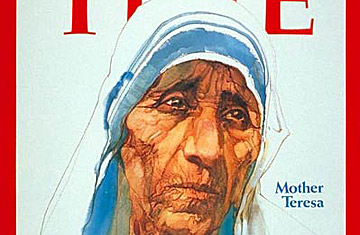
Mother Teresa
(4 of 10)
The woman who inspires such tribute was born to Albanian parents in Skoplje, Yugoslavia, in 1910, and baptized Agnes Gonxha Bojaxhiu. Even at the age of twelve, she remembers, she wanted to be a missionary, "to go out and give the love of Christ." The desire grew when some local Jesuits, freshly sent to India, wrote enthusiastic letters home about their work in the Bengal missions. By the time she was 18, Agnes had joined the Irish branch of Loreto nuns who were working in Calcutta. In 1937 she made her final vows.
By then Teresa had fallen into the academic life at St. Mary's High School in Calcutta. There she taught geography to Bengali girls from comfortable homes, later became principal. But the school was hard by Calcutta's Moti Jheel slum, and the contrast between the horror outside and the genteel world within the convent walls must have motivated her decision to work for the poor, though she claims that it did not. What did change her she remembers vividly.
It was Sept. 10, 1946; she was on a train to Darjeeling when she heard what she is certain was a call—from God. "A call within a call," she says, since she was already a nun. This time the invitation was to serve the poorest of the poor. By the spring of 1948, Mother Teresa had won permission to leave the cloister and work in the Calcutta slums. In August of that year she laid aside her Loreto habit and donned the blue-edged, coarse cotton white sari that would become her new order's uniform. After an intensive nurse's training course, she opened a slum school in Moti Jheel just before Christmas.
She was not alone long. Some of the young women who joined her—former students at St. Mary's—remember their own calls. Mother Teresa asked; they accepted. She believed fiercely that God would provide, and the little band lived literally from day to day, sharing with the destitute what they could cadge from charity. The sisters were to live little better than the poor they served. They were allowed only two of the humble saris (which still cost only $1) so that they could honestly teach that it is possible to stay clean with a single change of garment. Life became only slightly less precarious in 1950, when the Vatican approved their new congregation, the Missionaries of Charity, and they moved into quarters that still serve as the mother house.
Not until two years later did the sisters take on one of their harshest and most widely admired tasks, care of the dying. Mother Teresa remembers finding a dying woman on the sidewalk, her feet half chewed away by rats, her wounds alive with maggots. Only with great difficulty did she persuade a hospital to take the woman. Within days the nun was pleading with authorities for "just one room" to which she could take the dying. What they gave her was a onetime pilgrims' rest house near the Temple of Kali, the Hindu goddess of death. She renamed it Nirmal Hriday—Pure Heart—and filled it.
